Visual Communication
can be a structural adaptation - a badge or it can be a behavioral
adaptation - a display.
Badges
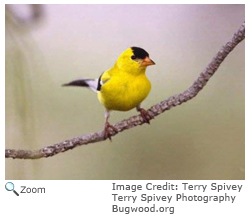 Animals often communicate using structural adaptations like the bright yellow color of the male American goldfinch. A structural adaptation that is used to communicate is called a badge. Animals often communicate using structural adaptations like the bright yellow color of the male American goldfinch. A structural adaptation that is used to communicate is called a badge.
I Have the Power
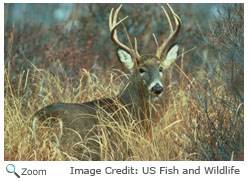 The male white-tailed deer has antlers. The size of the antlers is a badge that can tell another male deer how powerful the other deer is. The larger the antlers, the more powerful the deer! The male white-tailed deer has antlers. The size of the antlers is a badge that can tell another male deer how powerful the other deer is. The larger the antlers, the more powerful the deer!
Looking for Mr. Right
 Badges can also help females pick a mate. Many male bird's, like the northern cardinal, have brightly colored feathers. The brighter a male birds feathers, the healthier it is. Healthy animals make better mates than the weaker animals, because their offspring will be stronger and better able to survive. Badges can also help females pick a mate. Many male bird's, like the northern cardinal, have brightly colored feathers. The brighter a male birds feathers, the healthier it is. Healthy animals make better mates than the weaker animals, because their offspring will be stronger and better able to survive.
I'm Warning You!
 Sometimes, the color or pattern of an animal is a badge that serves as a warning to other animals to stay away! The gila monster's bright orange colored splotches are a warning to predators that the gila monster is poisonous and they should back off.. Sometimes, the color or pattern of an animal is a badge that serves as a warning to other animals to stay away! The gila monster's bright orange colored splotches are a warning to predators that the gila monster is poisonous and they should back off..
| |
Displays
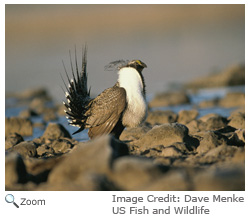 When an animal exhibits a behavior that can be seen by other animals, it is called a display.
Displays can be used to attract a mate or to warn off a predator.
When a sage grouse opens its tail feathers and struts around trying to attract the attention of a female, that is a display.
When a cat arches its and raises its fur, that is also a display.
Who's the Man?
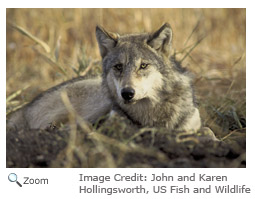 Wolves and dogs put their tails between their legs and lie on their backs to show submission to another wolf or dog and to let them know they are not a threat.
When wolves (and
dogs) want to show dominance they stare at each other, raise their fur
and bare their teeth. This lets the other wolf or dog know that they want
to be the top, or dominant, animal.
Look at Me!
 Many animals use visual displays to attract a mate. A female American crocodiles tries to get the attention of a male by lifting her head and showing her neck. She will also use tactile communication and rub up against the side of the male's head and neck. This lets the normally aggressive male know that she is not aggressive!
And the Winner Is...
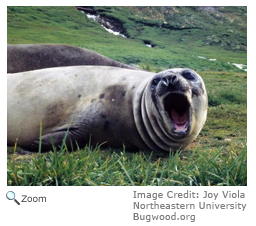 Male elephant seals go through a series of vocal and visual displays of aggression when they are competing for a mate. Eventually one male emerge as the winner.
|
 When an animal exhibits a behavior that can be seen by other animals, it is called a display.
Displays can be used to attract a mate or to warn off a predator.
When a sage grouse opens its tail feathers and struts around trying to attract the attention of a female, that is a display.
When a cat arches its and raises its fur, that is also a display.
When an animal exhibits a behavior that can be seen by other animals, it is called a display.
Displays can be used to attract a mate or to warn off a predator.
When a sage grouse opens its tail feathers and struts around trying to attract the attention of a female, that is a display.
When a cat arches its and raises its fur, that is also a display.
 Wolves and dogs put their tails between their legs and lie on their backs to show submission to another wolf or dog and to let them know they are not a threat.
When wolves (and
dogs) want to show dominance they stare at each other, raise their fur
and bare their teeth. This lets the other wolf or dog know that they want
to be the top, or dominant, animal.
Wolves and dogs put their tails between their legs and lie on their backs to show submission to another wolf or dog and to let them know they are not a threat.
When wolves (and
dogs) want to show dominance they stare at each other, raise their fur
and bare their teeth. This lets the other wolf or dog know that they want
to be the top, or dominant, animal.
 Many animals use visual displays to attract a mate. A female American crocodiles tries to get the attention of a male by lifting her head and showing her neck. She will also use tactile communication and rub up against the side of the male's head and neck. This lets the normally aggressive male know that she is not aggressive!
Many animals use visual displays to attract a mate. A female American crocodiles tries to get the attention of a male by lifting her head and showing her neck. She will also use tactile communication and rub up against the side of the male's head and neck. This lets the normally aggressive male know that she is not aggressive!
 Male elephant seals go through a series of vocal and visual displays of aggression when they are competing for a mate. Eventually one male emerge as the winner.
Male elephant seals go through a series of vocal and visual displays of aggression when they are competing for a mate. Eventually one male emerge as the winner.




